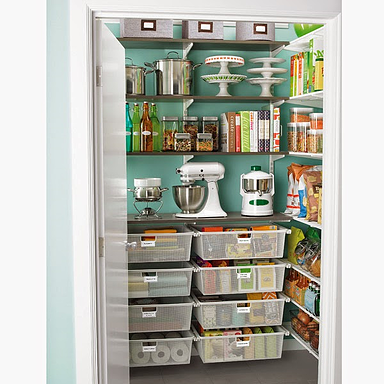How many times a day to you go in and out of your pantry? Do you ever wish it worked better for you? Or, maybe you are getting ready to sell your home. Pantry space can be a big perk for many home buyers. Houzz.com came up with nine questions to ask when planning your kitchen pantry:
1. Which way will the door open? 
A common mistake when planning a pantry is installing a door that gets in the way. When space is at a premium, the best options are sliding or folding doors. An outward-opening door gives more room for pantry shelves and is the next best option — but only if there is plenty of space to swing the door wide.
A door that opens inward can work, but be aware that it might make an already small space smaller. It can also compromise the space behind the door of your pantry, limiting the amount of stuff you can store there.
2. Will there be enough light?
Another typical mistake is to have either poor lighting in the pantry or none at all. Your pantry will more than likely be built without a window or with just a small one. One way to make sure that you have enough light in there is to install quality LED lighting. Also, the light switch should be reachable and in an accessible spot by the pantry door.
3. How can top shelves be accessed?
There is no point in planning a pantry with floor-to-ceiling storage if you can’t access the items on the top shelf. If your pantry is large enough, park a ladder on a sliding rail to access the infrequently used items on the top shelves. Store things you regularly use farther down.
If your pantry is small, store a step ladder in a handy spot for easy access. Inexpensive plastic single steps also can be folded flat and hung on a hook.
Solid polished wood shelves or powder-coated metal racks are attractive options. A cheaper alternative is engineered wood. Plywood is strong and looks contemporary, especially when left in its raw state or given a light stain.
You not only need your pantry to be well illuminated, you also need to get in and out of your pantry quickly when cooking. If the pantry is positioned in such a way as to hinder the flow of kitchen traffic, you’ll have to walk too far to grab essential ingredients. For that reason, it’s important that your pantry is near where you are preparing food.
Also consider the process of stocking your pantry and where it will be in relation to counters and tables. A kitchen countertop that is just outside a pantry will prove convenient for setting down groceries. Its close proximity also makes using it as a sorting station from which to fill pantry shelves extremely handy.
Obviously put the items you use the most on the shelves that are in front of you when you walk into the pantry. Make sure the shelves are not too deep, and that you can see everything at once by placing smaller items at the front and larger items at the back. Heavy dishware and servingware can be stored on shelves that are wider and lower down.
It’s really only in the planning stage that you can incorporate special features that will become permanent but useful fixtures in your walk-in pantry. Special features could include pullout baskets for root vegetables, narrow cubbies for large platters, and spice or wine racks.
Every bit of space can be used to solve a storage problem, and a pantry wall is no different. Whatever you decide to do with it, keep it simple and slim. Ideas include hooks for aprons and utensils, and a household calendar to note important family events. A chalkboard painted on a section of the wall could also serve this purpose.
Appliances and cookware dishes and pans often are kept in the pantry instead of in a kitchen drawer or cabinet, mostly because it’s easier to access them. To accommodate these bulky items, create some large but uniformed cubbies.
Are you thinking about selling your home? Email us at concierge@lizmoore.com, or click below, and we can prepare a complimentary analysis of market value for you – you just may be pleasantly surprised.
Are you interested in hot real estate topics, tips and trends?
Click below to subscribe to our blog!
Tags:
Sellers

